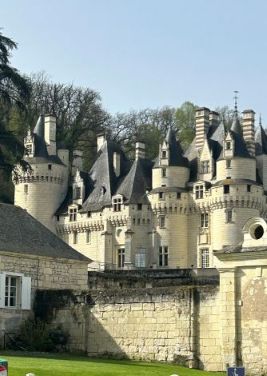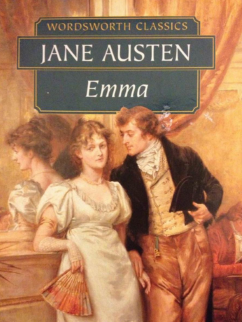…and reading a little Balzac while I do it.

We’ve just bought a long-neglected house in the French village of Rigny-Ussé in Touraine. It’s the village of the Chateau d’Ussé (pictured at left), featured in Charles Perrault’s 1697 story “La Belle Au Bois Dormant” — or “The Sleeping Beauty in the Wood.” Walt Disney modeled his Sleeping Beauty castle on this chateau. I can see its turrets from my bedroom window.
In Perrault’s telling, Princess Aurora is put to sleep with her little dog, Puff, at her side. As the prince enters the castle grounds, a hundred years of bramble growth melts away by itself. Aurora wakes up, not to a kiss, but to the prince kneeling beside her. Then, “to be brief, after four hours of talking they had not succeeded in uttering one half of the things they had to say to each other.”
In another charming detail, having been asleep for a century, Aurora is dressed in old-fashioned granny clothes, but the prince politely says nothing.
Our house is another sleeping beauty. It’s been stopped in time, with its tall, shuttered windows, marble fireplaces, and quaintly wallpapered rooms. We are reawakening its charm to discover all it has to tell us. There’s an old stone bread oven in the wall of a room downstairs, and the gate at the end of our overgrown garden leads to the Indre River.
Every morning, we walk along the river. It’s April, and the grass is full of daisies and dandelions. All the willow trees are greening up. An old wooden boat is docked in the shade of the riverbank, and the blackbirds, chaffinches, and mourning doves fill the air with birdsong. At dusk, we sometimes see a heron circling overhead. Everything here feels timeless but somehow also time-filled, redolent as it is with the past and a promise for the future.
Touraine has long been a source of inspiration. Frédéric Chopin and George Sand summered for years on the Indre, where Chopin composed most of his piano music. Max Ernst produced work here, and Alexander Calder had a studio in nearby Saché. Honoré de Balzac was often a guest at the Chateau de Saché on the Indre. He wrote a lot of his stories here, including the novel The Lily in the Valley, often working through the night. Now, the chateau is the Balzac Museum.
My daughter Rozzie gave me a copy of The Lily in the Valley and I’ve been reading it over the last several weeks. In the story, Balzac explores the madness of an unconsummated passion, as well as the supposed dichotomy between a soul connection and an ego-driven physical one.
It begins with an embarrassing faux pas. An ardent young man named Félix de Vandenesse impulsively throws himself upon a beautiful older woman at a ball and feverishly kisses her white shoulders. Unsurprisingly, he is rebuffed.
But Félix cannot help himself. He’s hopelessly infatuated. He pursues this woman, Henriette, although she tells him she wants only to love him as a son.
They become devoted companions and exchange many furtive glances. Henriette is married to the impossible Count de Mortsauf, who has both money and mental problems. But although she and Félix are twin souls, Henriette holds him at bay. Only when she’s dying does she give him a letter, revealing that she passionately loved him all along. She tells him about the paroxysms of ecstasy she used to experience at the mere sight of him and admits to tricking her daughter into uttering his name when he wasn’t there because she “so adored that tingly feeling.”
The melodrama of her deathbed scene rivals that of Dickens’ Little Nell in The Old Curiosity Shop. Oscar Wilde famously wrote of that scene, “One would need to have a heart of stone to read the death of Little Nell without bursting into tears…of laughter.”
Wilde was a great one for stripping away pretensions. He also wrote that “the nineteenth century as we know it is largely an invention of Balzac’s.” The age was characterized by moral and sexual hypocrisy and the need to keep up appearances.
Henry James was another admirer of Balzac. He also wrote about missed romantic connections. I thought of James when I read Balzac’s story “A Passion in the Desert.” In it, a soldier encounters a female panther in the desert and tames its savage urges. It’s described like a seduction. James’ “The Beast in the Jungle,” another story about repressed sexuality, uses the same metaphor of an animal ready to pounce. I’m betting Balzac inspired him.
But the final pages of The Lily in the Valley have a surprisingly modern twist. Natalie, Félix’s romantic interest to whom the story is written, scoffs at his madness and pokes fun at his morality. “Do you know the woman I pity?” she writes to him. “The fourth woman you love. Of necessity, she will be forced to fight the three others, and thus...I renounce the glorious task of loving you.”
Carpe diem! That’s my takeaway! Live your passions and make your dreams come true. So, back to renovating our sleeping beauty of a house. There’s lots of work ahead, and the brambles in our garden will not melt away by themselves. But you know what they say about inspiration. It makes the hard work possible.
The Lily in the Valley also includes evocative passages about Touraine, the walnut trees in nearby Bréhémont, and the annual grape harvest. “Don’t ask me again why I love Touraine,” Balzac writes. “...I love it as an artist loves his art; I love it less than I love you, but perhaps without Touraine, I would no longer be alive.”
Amanda Holmes Duffy is a columnist and poetry editor for the Independent and the voice of “Read Me a Poem,” a podcast of the American Scholar.

.png)